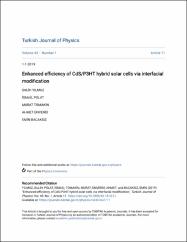Enhanced efficiency of CdS/P3HT hybrid solar cells via interfacial modification
Citation
Yılmaz, S., Polat, İ., Tomakin, M., Ünverdi, A. & Bacaksız, E. (2019). Enhanced efficiency of CdS/P3HT hybrid solar cells via interfacial modification. Turkish Journal of Physics, 43(1), 116-125. https://doi.org/10.3906/fiz-1810-21Abstract
The present paper examines the effects of surface modification of CdS with diverse dyes on fabricated CdS-based hybrid solar cells. the X-ray diffraction results showed that CdS thin films had a hexagonal phase with a preferred orientation along the (101) plane. Scanning electron microscopy indicated that the CdS specimen was composed of a granular structure while a P3HT layer was formed from tiny grains. Band gaps of the CdS thin films and the P3HT layer were 2.45 eV and 1.98 eV, respectively. the absorption spectra showed that different dye loading caused an increase in the absorbance of CdS thin films in the wavelength range of 400-650 nm. the photoluminescence of the CdS/P3HT structure including various dyes was lower than that of the pristine one, implying that efficient charge separation was achieved upon surface modification. Current density-voltage curves showed that the ITO/CdS/N719/Ag hybrid solar cell exhibited the best overall efficiency of 0.082%, which can be attributed to improvements in both short circuit current density (J(sc)) and open circuit voltage (V-oc). These enhancements can be attributed to the creation of better interfacial contact between CdS and P3HT layers after dye loading.


















